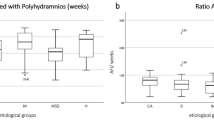Abstract
Purpose
To analyze postnatal abnormalities in idiopathic polyhydramnios and to estimate whether there was an association between the severity of polyhydramnios and postnatally diagnosed abnormalities.
Methods
This was a retrospective cohort study of all idiopathic polyhydramnios cases delivered at our center between 2017 and 2021. Cases were identified as idiopathic after excluding known fetal genetic or structural abnormalities (including soft markers for aneuploidies), Rh isoimmunization, fetal anemia, multifetal pregnancies, pregestational or gestational diabetes, and known infection with TORCH group agents. The primary outcome was the association between polyhydramnios degree and any abnormalities detected after birth. Additional outcomes were the odds of specific groups of abnormalities based on polyhydramnios degree.
Results
The prevalence of idiopathic polyhydramnios was 14.7%. Outcomes of 242 pregnancies with idiopathic polyhydramnios were analyzed. At least one neurodevelopmental, structural, or genetic abnormality was diagnosed in 16.1% of children born to women with idiopathic polyhydramnios. Moderate and severe polyhydramnios are significantly associated with at least one abnormality diagnosed after birth (45.9%, and 41.6%, respectively, p < 0.05). Neurodevelopmental disorders were the most frequent abnormality (5.4%), followed by genetic abnormalities (4.1%) and gastrointestinal abnormalities (2%). Odds of genetic abnormalities and neurodevelopmental disorders in moderate polyhydramnios were significantly higher compared to mild [OR 2.6; 95% CI 1.1–4.3 and aOR 2.4 (95% CI 1.1–3.6) respectively]. As expected, gastrointestinal anomalies were significantly associated with severe polyhydramnios [OR 3.2 (95% CI 1.9–5.5)].
Conclusion
Moderate and severe idiopathic polyhydramnios are associated with anomalies diagnosed after birth. Particularly high risks include neurodevelopmental disorders, genetic abnormalities, and gastrointestinal atresias.

Similar content being viewed by others
References
Dashe JS, McIntire DD, Ramus RM, Santos-Ramos R, Twickler DM (2002) Hydramnios: anomaly prevalence and sonographic detection. Obstet Gynecol 100(1):134–139. https://doi.org/10.1016/s0029-7844(02)02013-6
Bauserman M, Nathan R, Lokangaka A, McClure EM, Moore J, Ishoso D, Tshefu A, Figueroa L, Garces A, Harrison MS, Wallace D, Saleem S, Mirza W, Krebs N, Hambidge M, Carlo W, Chomba E, Miodovnik M, Koso-Thomas M, Liechty EA, Esamai F, Swanson J, Swanson D, Goldenberg RL, Bose C (2019) Polyhydramnios among women in a cluster-randomized trial of ultrasound during prenatal care within five low and low-middle income countries: a secondary analysis of the first look study. BMC Preg Childb 19(1):258. https://doi.org/10.1186/s12884-019-2412-6
Dashe JS, Pressman EK, Hibbard JU (2018) SMFM Consult Series #46: evaluation and management of polyhydramnios. Am J Obstet Gynecol 219(4):B2-b8. https://doi.org/10.1016/j.ajog.2018.07.016
Ott WJ (2005) Reevaluation of the relationship between amniotic fluid volume and perinatal outcome. Am J Obstet Gynecol 192(6):1803–1809. https://doi.org/10.1016/j.ajog.2004.12.062. (discussion 1809)
Abele H, Starz S, Hoopmann M, Yazdi B, Rall K, Kagan KO (2012) Idiopathic polyhydramnios and postnatal abnormalities. Fetal Diagn Ther 32(4):251–255. https://doi.org/10.1159/000338659
Kyriacou C, Roper L, Mappouridou S, Lees C, Prior T (2021) Contemporary experience of polyhydramnios: a single-centre experience. Austral J Ultrasound Med 24(3):137–142. https://doi.org/10.1002/ajum.12247
Pritchard JA (1966) Fetal swallowing and amniotic fluid volume. Obstet Gynecol 28(5):606–610
Sherman DJ, Ross MG, Day L, Hummel J, Ervin MG (1991) Fetal swallowing: response to graded maternal hypoxemia. J Appl Physiol (1985) 71(5):1856–1861. https://doi.org/10.1152/apply.1991.71.5.1856
Adamczyk M, Kornacki J, Wirstlein P, Szczepanska M, Wender-Ozegowska E (2019) Follow-up of children with antenatally diagnosed idiopathic polyhydramnios. Ginekol Pol 90(2):93–99. https://doi.org/10.5603/GP.2019.0016
Kornacki J, Adamczyk M, Wirstlein P, Osiński M, Wender-Ożegowska E (2017) Polyhydramnios—frequency of congenital anomalies in relation to the value of the amniotic fluid index. Ginekol Pol 88(8):442–445. https://doi.org/10.5603/GP.a2017.0081
Yefet E, Daniel-Spiegel E (2016) Outcomes from polyhydramnios with normal ultrasound. Pediatrics 137(2):e20151948. https://doi.org/10.1542/peds.2015-1948
Sagi-Dain L, Singer A, Falik-Zaccai T, Peleg A, Bar-Shira A, Feingold-Zadok M, Ben Shachar S, Maya I (2021) The effect of polyhydramnios degree on chromosomal microarray results: a retrospective cohort analysis of 742 singleton pregnancies. Arch Gynecol Obstet 304(3):649–656. https://doi.org/10.1007/s00404-021-05995-y
Ben-Chetrit A, Hochner-Celnikier D, Ron M, Yagel S (1990) Hydramnios in the third trimester of pregnancy: a change in the distribution of accompanying fetal anomalies as a result of early ultrasonographic prenatal diagnosis. Am J Obstet Gynecol 162(5):1344–1345. https://doi.org/10.1016/0002-9378(90)90058-f
Duel BP, Steinberg-Epstein R, Hill M, Lerner M (2003) A survey of voiding dysfunction in children with attention deficit-hyperactivity disorder. J Urol 170(4 Pt 2):1521–1523. https://doi.org/10.1097/01.ju.0000091219.46560.7b. (discussion 1523–1524)
Dorleijn DMJ, Cohen-Overbeek TE, Groenendaal F, Bruinse HW, Stoutenbeek P (2009) Idiopathic polyhydramnios and postnatal findings. J Matern Fetal Neonatal Med 22(4):315–320. https://doi.org/10.1080/14767050802531870
Saleem H, Simpson B (2022) Biotinidase deficiency. In: StatPearls. StatPearls Publishing Copyright © 2022, StatPearls Publishing LLC., Treasure Island
Rodríguez-Soriano J (1998) Bartter and related syndromes: the puzzle is almost solved. Pediatr Nephrol 12(4):315–327. https://doi.org/10.1007/s004670050461
Funding
The authors declare that no funds, grants, or other support were received during the preparation of this manuscript.
Author information
Authors and Affiliations
Contributions
SG: project development, data collection, manuscript writing. IA: data analysis, manuscript writing. LU: manuscript writing. BO: data collection. OD: project development, supervision, manuscript writing. All authors contributed to the study's conception and design. SG, IA, and BO performed material preparation and data collection. The first draft of the manuscript was written by IA, and all authors commented on previous versions of the manuscript. All authors read and approved the final manuscript.
Corresponding author
Ethics declarations
Conflict of interest
The authors declare that there is no conflict of interest.
Ethics approval
This study was performed in line with the principles of the Declaration of Helsinki. Approval was granted by the Ethics Committee of Zeynep Kamil Women and Children’s Diseases Training and Research Hospital (Decision number: 188).
Additional information
Publisher's Note
Springer Nature remains neutral with regard to jurisdictional claims in published maps and institutional affiliations.
Rights and permissions
Springer Nature or its licensor (e.g. a society or other partner) holds exclusive rights to this article under a publishing agreement with the author(s) or other rightsholder(s); author self-archiving of the accepted manuscript version of this article is solely governed by the terms of such publishing agreement and applicable law.
About this article
Cite this article
Gürel, S., Ayhan, I., Uygur, L. et al. What to expect after birth in idiopathic polyhydramnios? An analysis of postnatal diagnoses and their relationship to the polyhydramnios degree. Arch Gynecol Obstet (2023). https://doi.org/10.1007/s00404-023-07216-0
Received:
Accepted:
Published:
DOI: https://doi.org/10.1007/s00404-023-07216-0




